Now that the 2017 World Series is over, I am returning to baseball nostalgia for three posts on the World Series of 50, 75 and 100 years ago. This first post features the 1917 Series. The others will be (i) 1942, when the World Series of the Negro Leagues and MLB each featured seven Hall of Famers, and (ii) 1967, when Bob Gibson ruled the World Series.
Presidential First Pitches – Taft and Wilson: In 1909, President William Howard Taft went to a major league game at the urging of his military aide Major Archie Butt. Taft enjoyed the experience and went to several games while in office. In 1910, he became the first president to throw out a first pitch to open a season in Washington. Archie Butt was with him for that 1910 first pitch, and the two of them were back the next year for the 1911 opener. They would not repeat in 1912 because the Titanic went down on April 15, four days before opening day. Wilson was too distraught – his friend Archie Butt had died as a passenger on the Titanic.
President Woodrow Wilson kept the opening day tradition alive in his first year in office in 1913. He repeated the ceremony in 1915 and 1916. Opening day in 1917 was set for April 21, but two weeks before that, at the request of President Wilson for “a war to end all wars,” Congress declared war on Germany. Wilson sent Vice President Thomas Marshall to throw out the first pitch. Because of the war and then ill health, Wilson never threw out another opening day pitch.
White Sox (1917) and Black Sox (1919): Most baseball fans know about the 1919 Chicago White Sox, the team that became known as the Black Sox when eight players conspired to throw the Series. But what most fans do not remember is that those same eight players and their White Sox teammates WON the World Series just two years earlier. The 1917 team featured two players destined for the Hall of Fame. Eddie Cicotte won 28 games in 1917 and 207 in his 14-year career. Shoeless Joe Jackson hit .408 in his 1911 rookie year and .356 in his 13-year career, behind only Ty Cobb and Rogers Hornsby. Jackson is the subject of one of the best-known photos by the legendary photographer Charles Conlon:
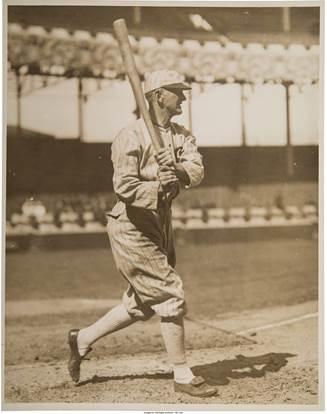
After the White Sox won the 1917 Series, they thought they would be rewarded by owner Charles Comiskey. They were sadly mistaken. Comiskey’s stinginess carried over to 1919. A prime example was Eddie Cicotte who was to get a big bonus if he won 30 games. He was on the way to do that when he was held out of some games in August. Cicotte finished with 29 wins and Comiskey paid him nothing extra. The players were not happy.
Comiskey would end up paying, but in a different way. First baseman Chick Gandil recruited Eddie Cicotte, Shoeless Joe Jackson and five others to join in the conspiracy to throw the 1919 Series. All were indicted, and although they were acquitted, the “Eight Men Out” were banned from the major leagues. Charles Comiskey and his descendants owned the White Sox for another 40 seasons, none ending with a win in the World Series. Maybe Comiskey should have given Cicotte his bonus.
1917 World Series – Chicago White Sox v. New York Giants: As baseball played out the 1917 season, the league champions were the White Sox and the Giants. The World Series program featured President Wilson, and the caption inferred that he had thrown out the first pitch to begin the 1917 season. He had not – the photo was from his 1916 pitch. The rest of the caption, again somewhat misleading, reads “A BIG ENOUGH BOY TO ENJOY THE NATIONAL GAME—AND—A MAN BIG ENOUGH TO GUIDE OUR COUNTRY THROUGH ITS GREATEST CRISIS.”
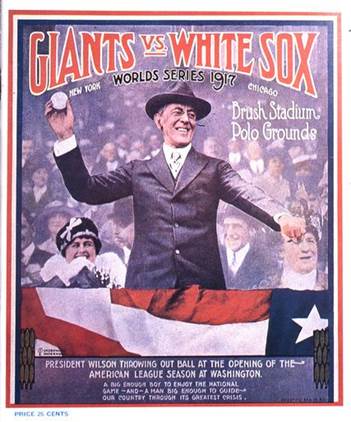
The White Sox had their best season ever, finishing 100-54. The elite pitching staff included knuckleballer Eddie Cicotte, spitballer Red Faber and southpaw Lefty Williams. The offense was also strong with Shoeless Joe Jackson, Chick Gandil, Eddie Collins, Ray Schalk and Happy Felsch.
The Giants were led by legendary manager John McGraw. Unlike the White Sox, the Giants lacked superstars (none made the Hall of Fame), but a balanced lineup led the team to the pennant.
With the backdrop of the war, the Chicago White Sox wore patriotic jerseys for the World Series. The usual black “SOX” logo was replaced by blue letters outlined in red and white with stars within the “S”. There were also flag patches on both sleeves.
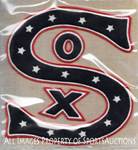
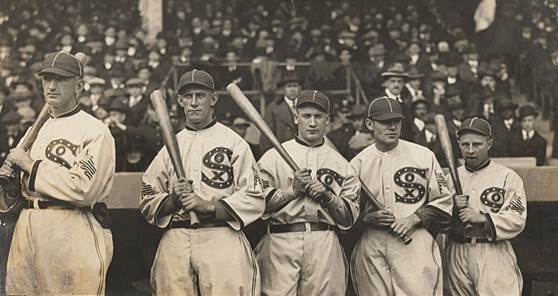
The White Sox won the Series, four games to two. My favorite statistic is that Eddie Cicotte and Red Faber pitched 50 of the 52 innings for the White Sox. Second baseman Eddie Collins was the Sox hitting star with an average of .409. Faber, Collins and catcher Ray Schalk are in the Hall of Fame.
“The Play” of the 1917 World Series: The final game of the Series is best known for a botched play by the Giants. The White Sox led the Series, three games to two. In Game 6, with the game tied 0-0 in the top of the 4th, Eddie Collins of the White Sox reached first on a bad throw by Giants third baseman Heinie Zimmerman. Next up was Shoeless Joe Jackson who likewise reached first on an error and Collins moved to third. The next batter was Happy Felsch who hit a bouncer back to the pitcher who threw to Zimmerman at third to catch Collins in a rundown. Zimmerman threw to the catcher as Collins headed to home, and when Collins stopped, the catcher threw back to third. Collins then slipped by the catcher and headed to home which should have been covered by the Giants pitcher or first baseman. It was not, so all Zimmerman could do was race Collins to home, but he did not make it in time. In the photo below, the parties are the Giants catcher (1), umpire Bill Klem (2), the sliding Collins (3) and Zimmerman leaping over Collins to avoid a collision (4).
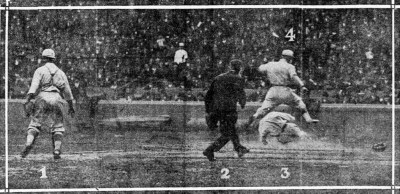
During the rundown, Jackson and Felsch moved to second and third. The next batter, Chick Gandil, hit a single to knock in two runs. The White Sox had scored three times on two errors, a fielder’s choice and one hit. The runs held up as the Sox won the game (4-2) and the Series. Three of the four White Sox players involved in the 4th inning scoring (Jackson, Felsch, Gandil) were later banned from baseball for their part in the Black Sox scandal. The fourth, Eddie Collins, is in the Hall of Fame. As for the Giants third baseman who chased Collins to home plate…
Heinie Zimmerman: Zimmerman started his career with the Chicago Cubs as a utility infielder when the Cubs won the World Series in 1907 and 1908. It was difficult to become a starting middle infielder when the Cubs had Tinker-to-Evers-to-Chance. He eventually moved to third base and had several good seasons, the best being in 1912 when he led the league in hitting, homers and RBIs, the “Triple Crown.”
Zimmerman was included in the storied T206 baseball card series made famous by the Honus Wagner card that is the most valuable card of all time.
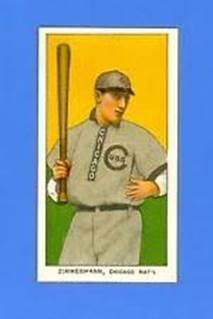
By 1916, Zimmerman was considered a problem player because of careless spending, family discord and erratic play. He was traded to the Giants in August of 1916 after being suspended for ten days by the Cubs for “laying down on the job.” Giants manager John McGraw thought he could rehabilitate him, and he was rewarded when Zimmerman led the league in RBIs in 1917.
Although the botched rundown in the 1917 Series was not Zimmerman’s fault, he took considerable heat from the fans and sportswriters. From the New York Times: “The great crowd shook with laughter and filled the air with cries of derision at one of the stupidest plays in a world series. Zim thought it was a track meet instead of a ball game and wanted to match his lumber wagon gait against the fleetest player in the game.”
Zimmerman’s play suffered in 1918 and 1919, but even worse, he became known as a friend of gamblers. The Black Sox players were not the only ones under suspicion by 1919. Gambling on games was common and players were notoriously underpaid by many owners. Manager John McGraw testified in the Black Sox trial that he knew that Zimmerman and other players on his Giants team were working with gamblers. This ended Zimmerman’s time in the major leagues. His shady dealings would continue, including running a New York speakeasy for racketeer Dutch Schultz in 1929-30.
Videos of the 1917 World Series: During my research for this post, some of my favorite finds were videos. The fans are a treat in their suits and hats. If you have the time and inclination: Video 1 (4:36); Video 2 (4:38); Video 3 (1.:29).
Curb Your Enthusiasm and the Black Sox: As indicated in an earlier Hot Stove, Rita and I are fans of Larry David’s Curb Your Enthusiasm. In this season’s second episode, there was some baseball gold. Larry and his house guest Leon – for those not into Curb, Leon is African-American – are setting up a diversion in a hotel lobby (would take too long to explain why). Part of the ploy is for Leon to have an alias, and the two bicker over what it should be. Here is the exchange, deleting the HBO-approved curse words:

To set the mood, please click on this one minute intro: Curb Your Enthusiasm Theme.
Leon: “I want a name.” [an alias]
Larry: “Chick Gandil, that’s your name. He played first base for the 1919 White Sox, the team that threw the World Series.”
Leon: “Wait a minute. I’m not gonna be no White Sox.” Larry: “Would you prefer somebody from the Negro Leagues?”
Leon: “Yeah, give me a name.” Larry: “Chappie Johnson.”
Leon: “That’s a black man’s name right there. That’s great. I love it. All right.”
The Curb Your Enthusiasm writers know their baseball. As noted earlier in this post, Gandil was the gambling ringleader of the Black Sox. As for Chappie, he was a catcher for some of the best Negro League teams from 1895 to 1920.
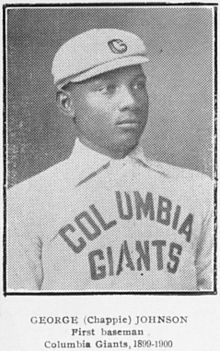
[Larry David Trivia: Before Curb Your Enthusiasm, David was best known as the co-creator of Seinfeld. Tomorrow is the 25th anniversary of the quintessential episode of Seinfeld: “The Contest,” written by Larry David. If you don’t know what the contest was about, or if you love Seinfeld like me and still watch the reruns, the three-minute setup of the contest is here. (PG-13, maybe)]
World Series Curses: The White Sox won the Series in 1917. The Red Sox, led by pitcher Babe Ruth, won in 1918. Then came 1919. Bad news for both teams. Curses were in the making that lasted 80 plus years.
For the Red Sox, it was the “Curse of the Bambino” – punishment for selling Ruth to the Yankees after the 1919 season. The Red Sox did not win another World Series until 2004.
For the White Sox, it was the “Curse of the Black Sox” that kept the team from winning another World Series until 2005.
If you believe in curses.
Lonnie’s Twitter Feed: Moving back to the present day, some short takes.
I thought the MVP race in the American League would be a close vote between Houston’s Jose Altuve (5’6”) and the Yankees Aaron Judge (6’7”). But, to my delight, Altuve got 27 of the 30 first place votes and is the MVP. I think Judge is a great talent and certainly deserved his unanimous choice as AL Rookie of the Year. The only players to win both MVP and ROY in the same year are Fred Lynn (1975) and Ichiro Suzuki (2001).
The Royals have completed the full replacement of the playing field at Kauffman Stadium, nicely captured in a time-lapse video by the KC Star’s John Sleezer. Click here (2:42).
The Hall of Fame has released the 2018 Modern Baseball Era Committee ballot. This is one of the committees that provides an avenue to the Hall of Fame outside the normal baseball writers process. There are nine players on the ballot and one executive, Marvin Miller, the man who beat the baseball establishment time and again on behalf of the players. Miller has been passed over several times, and it is time to vote him in. Jay Jaffe, one of the best commentators on who should (and should not) be in the HOF, has written a compelling argument on Miller’s behalf in Sports Illustrated. See it here. Results will be announced on December 10.
Carlos Beltran has retired. I will likely be talking in a future post about his Hall of Fame chances. Spoiler alert: I think he should get in. Hopefully in a Royals cap on his plaque. He played for seven teams in his 20 seasons, but most of his games were with the Mets (839) and the Royals (795). Carlos wrote a nice goodbye to his fans, “Muchas gracias, béisbol”. Click here. Star photographer John Sleezer congratulated Carlos on his retirement by tweeting his photos of Beltran robbing a home run from Seattle’s Dan Wilson in 2003.

Thank you Carlos.